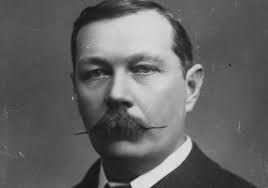‘Famous Authors Series – Sir Arthur Conan Doyle’ is our fourth post profiling famous authors.
I wonder if Sir Arthur (22 May 1859 – 7 July 1930) knew that his character Sherlock Holmes, created in 1887, would remain popular into the 21st century.
Upon the success of his character, he co-wrote the stage play Sherlock Holmes. This premiered in 1899 and closed after 200 performances. There were movie spin-offs in his lifetime, a radio adaptation starring the inimitable Orson Welles in 1938 after Doyle’s death, and even a musical.
Dear Sir Arthur couldn’t possibly have imagined the countless movies and TV series based on his character that have followed since.
Who was Sir Arthur Conan Doyle?
The creator of Sherlock Holmes was a British writer and medical doctor. He was born in Edinburgh of Catholic parents. His father was an alcoholic, which caused the family to separate when Arthur was only five years old. When the family reunited in 1867, they lived in squalid tenement flats. His father died in 1893 after a lengthy psychiatric illness.
At the age of nine, and supported financially by wealthy uncles, our hero’s creator went to England for his education until 1875. Of his later schooling, he said he had no fond memories of it. The school was harsh, without compassion and warmth, favouring corporal punishment and ritual humiliation. It was run on medieval principles. Further, the academic system could only be excused ‘on the plea that any exercise, however stupid, forms a sort of mental dumbbell by which one can improve one’s mind.’
As an adult, he rejected his Catholic faith and became an agnostic, and later a spiritualist mystic.
A doctor destined to be a writer
Between 1876 and 1881, Doyle studied medicine in Edinburgh. He also studied practical botany and began writing short stories. In 1879, his first published academic article, Gelsemium as a Poison, had a far-reaching influence. Some 136 years later in a 21st-century murder investigation, The Sunday Telegraph considered his article potentially useful.
Upon graduating with a Bachelor of Medicine and Master of Surgery degrees, he became a ship’s surgeon, travelling to the West African coast. He then completed an advanced Doctor of Medicine degree.
At 23, Doyle set up a medical practice in Plymouth with a partner. However, he soon left to set up an independent practice in Portsmouth. He had less than £10 (around £1000 today) to his name. The practice was unsuccessful and he returned to writing fiction. Nine years later, he studied ophthalmology in Vienna and eventually set up in practice in the UK. However, this practice did not flourish either.
Clearly, he was destined to be a writer, not a doctor.
Doyle wrote four novels and 56 short stories about Holmes and Dr Watson. He was a prolific writer. Aside from his famous crime fiction, he wrote fantasy and science fiction stories, plays, romances, poetry, non-fiction and historical novels.
Who was Sherlock Holmes based on?
Doyle partially based Sherlock Holmes on his university teacher Joseph Bell, whose deductive and observational powers clearly inspired him. His contemporary, Robert Louis Stevenson, recognised the strong likeness between Joseph Bell and Sherlock Holmes, writing to Doyle from Samoa, ‘My compliments on your very ingenious and very interesting adventures of Sherlock Holmes … can this be my old friend Joe Bell?’
He almost killed Holmes off
When Doyle wrote to his mother saying he was thinking of killing off Holmes, she replied, ‘You won’t! You can’t! You mustn’t!’
Thank god for mothers.
He even raised his price to discourage publishers’ demands for more Holmes’ stories. However, they were willing to pay so well for them that he became one of the best-paid authors of his time.
His second murder attempt
Because he wanted to dedicate more time to his historical novels, Doyle made Holmes and Professor Moriarty plunge to their deaths down the Reichenbach Falls in Switzerland in the story The Final Problem. This time, it was the public, not his mother, who demanded Holmes’ resurrection, and Doyle featured him in the 1901 The Hound of the Baskervilles.
In 1903, in The Adventure of the Empty House, he explained away the death of Holmes by saying that only Moriarty had fallen. Holmes had merely staged his death to put his other enemies off his scent, he said.
Family
Doyle married twice, his first wife Louisa dying of tuberculosis. His second wife Jean survived him by ten years. Doyle had five children, two with his first wife and three with his second. However, all five children died without issue, so he has no living direct descendants.
Where there is no imagination there is no horror
Arthur Conan Doyle
Acknowledgements
Arthur Conan Doyle, Wikipedia https://en.wikipedia.org/wiki/Arthur_Conan_Doyle#cite_note-bob-23 Accessed 11 December 2020
Photo courtesy of publishersweekly.com
Hope you’ve enjoyed this post ‘Famous Authors Series – Arthur Conan Doyle’.
Find out more
Do you want to write a book to support your business? But you don’t know where to start? Would you like 1:1 mentoring all the way through?
Book a complimentary 30-minute friendly chat with Gail to find out about her book writing program ‘Write Your Nonfiction Book in 16 Weeks’: https://calendly.com/writedesignpub/30min
Contact us too about editing and our other editorial services. We can help with your book from go to whoa, and anywhere in between.


